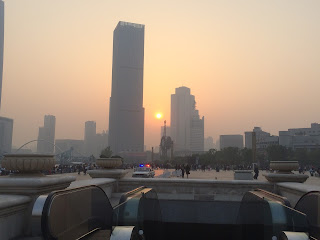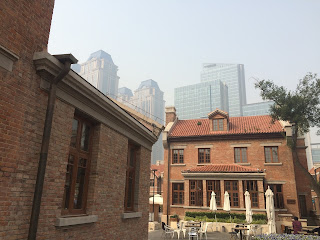It’s a Golden Week, a week’s worth of vacation because of
the National Holiday, and I’ve been stuck in Beijing. Sure, I’ve had damn good
Peking Duck, wandered around Beijing Design Week, had some pretty bourgey
Chuar, and took advantage of the some of the last beautiful days here by
strolling around what would be a friggin gorgeous city if you ignored the
orange tint of the air, but the traveller in me was getting incredibly restless.
So, I, with an intrepid fellow voyager, went to Tianjin.
One of the greatest things about China
post-2008/2009-stimulus is the amazing ease with which a poor-ish traveller can
get anywhere. All three major train stations in Beijing are accessible by pretty
direct subway paths from where I live (though it might take an hour. Have I
said it before? This city is gigantic), and the Jing-Jin high-speed railway
means that Tianijn, almost 100 miles away, is a 30-minute train ride. And it
costs $8.50 each way!
Shanghai South Station was a minor madhouse. I say minor,
because all in all it flowed pretty well. It was crowded, there were probably
many thousands of people in it, but it wasn’t a rabid sea of people like it
would’ve been had we travelled on the first day of the weeklong break. The building itself was so big and the air
quality so bad this day, though, that it was even hazy inside the dome of the
waiting room. Train boarding procedures were annoyingly similar to those in
America (line up at a “gate” some time before boarding to have your ticket
checked, all rush onto the train at the same time despite it being parked there
for a half hour), but at least they don’t bother check your tickets onboard
afterwards (take note, silly boarding procedures at Chicago Union Station).
 |
| "Please note the location of the 50 emergency exits..." |
We got on the train (ahh, technology “transferred” German
technology), kicked our seats back a few notches, and were off. The train hit
300km/h (186mph) in a matter of minutes, but you wouldn’t notice it from the
inside. The acceleration was perfectly smooth, and the train made its top speed
seem like the most normal thing in the world – no shudders, no exhilarating
rush of speed, just a pretty chill ride that just happened to be at 186mph. In
a sense, it was normal. This high-speed rail line had a train in each direction
roughly every 15 minutes during the day, and was paralleled by another a dozen
miles to the West that hosted the same. It didn’t hit me how polluted this day
was until we started gliding through the countryside ten minutes after leaving
Beijing South. The weather was technically clear, with no clouds to speak of,
but visibility didn’t extend further than a mile or two. All features beyond
this limit faded into the gray-beige haze that lay like a blanket over the
region.
 |
| Hey look, a development! |
I was personally surprised, after the large amount of press
given to the Jing-Jin-Ji (京津冀 – taken from the abbreviations for Beijing, Tianjin, and Hebei Province)
megalopolis project, at the amount of countryside still extant between
the two largest cities in Northern China. A consequence of the more centrally
planned top-down approach to city growth employed by the Chinese government
meant that (recently, at least) development usually happened in clusters of
high-rises instead of large areas of low-rise sprawl characteristic of American
suburbs. So, despite the occasional slender, 30-story-tall building emerging
out of the haze like the masts of old-timey ships through a heavy fog bank, the
majority of the distance we covered was through fields, older villages, and the
occasional small, planted forest. We passed the shells of two high-speed rail
stations, half-completed in preparation for some future planned communities to
rise around them. Currently they were surrounded by little other than the
freeway that the rail line paralleled and the Beijing/Tianjin countryside.
Our first sign of leaving the countryside once more was
passing through the first such development along the rail line to be completed
– the city of Wanqing, composed as far as I could tell entirely of residential
high-rises. It likely housed a not insignificant commuter population that
relied on the 25-minute rail connection to the capital to make their home
further from Beijing’s astronomical housing prices and oppressive congestion.
Ours was a non-stop service, so the train flew by Wanqing’s station without a
second thought.
Roughly a half hour after leaving Beijing South, we made it
to Tianjin Station, a masterpiece of early neo-futurist communist architecture (yes, I made that up, but I can't find any (English) source for its construction and architecture, but it looks really cool) situated on a bend of the Hai River in central Tianjin. The effect of leaving
the station was well done and not unlike the great placement of Venice’s
railway terminal – leaving the station, we were treated with a magnificent view
of the mess of architecture that defined Tianjin – the bend of the river across
from the train station hosted the colonial-era Jinwan plaza building, with some
of the city’s many supertall skyscrapers rising up behind it.
 |
| Tianjin Railway Station and the Hai River |
I’ll keep this “short” and focus on mainly two sights that we
passed through: St. Joseph’s Cathedral and the Five Great Avenues. I’m not
doing this because the rest of the city isn’t interesting—on the contrary, I
could write another five pages about all the quirks and little things that make
Tianjin worth a visit—but saving you, the reader, from what is probably a
pretty boring bit of my diary, I will limit my discussion to the things I saw
with what I thought were the most interesting backstories.
At the end of Binjian Street (Tianjin's main shopping street) was St. Joseph’s Cathedral (locally
known as the Xikai (西开) – ‘open to the west’, I believe – Cathedral), the largest
church in the area. It was built by French Jesuits in 1917 within a Catholic
community likely still haunted by the Tianjin Church Incident/Massacre/Event/whatever it is currently called in 1870, in which
a mob, angry about the Church’s alleged rather ‘active’ orphan collecting
activities in the city (and also angry about missionary activities in general
as a symptom of Western involvement) attacked the Catholic presence in the city.
At the end of the day (This apparently included the French Consul ramming his
ceremonial saber into the desk of the local Chinese magistrate in anger at a
mob attack on the Wanghailou Church, and subsequently shooting his assistant. A different version of the story says that Consul Fontanier actually shot the
magistrate himself in public, sparking the riot, while an entirely different one claims that Fontainer knocked on the door with his sword, then ran out
yelling ‘I’m not afraid of the Chinese people’ before shooting a few and
getting killed by the crowd. So it goes with history, I guess.), 60 people were
dead, including the Consul and many church-affiliated people. Anyways. The
context is given because I can only assume that this ‘incident’ is the
background behind this pretty humorous (well, at least out of context) sign at
the entrance of the cathedral (pictured below) – do not destroy everything,
indeed (this isn't even a poor translation, as far as I can tell, the original Chinese says the same thing).
 |
| "No Love, Do Not Take Away, Do Not Destroy Everything" |
 |
| Catholic Power in China |
Our third destination was the 五大道 (5 great avenues)
area Southeast of the city center. This is the center of the lasting impact of
the colonial powers that once ran this city. More so than anywhere else in
China, the concessions were made into small versions of their respective home
countries. Due to the Chinese defeat in the Second Opium War, the Treaty of
Tianjin gave the usual suspects (England, France, Japan, Germany, Russia) and
some unexpected new faces (Belgium, Italy, and, yes, Austria-Hungary, this is
what sending one ship and a couple of marines to a war got you those days. The
United States got a concession too, but not as a result of this treaty) large
swaths of the city to do with what they pleased, and they went to town with ‘em
(so to speak). A stunning array of massive British, French, and German-style
mansions lined the streets, presumably built for various merchants and
officials that effectively ran the city for several decades. Funnily enough,
many of these became the private homes of some of the various warlords (or
their concubines) that controlled China between the fall of the Qing Dynasty in
1911 and the (first) reunification by the KMT in 1928. There’s probably a
weird, but fascinating story behind their moves to Tianjin. Will keep you updated
if I find it.
 |
| This place is *entirely* filled with yuppie restaurants and stores |
 |
| There are even small cafes everywhere! |
Tianjin has a
completely different feel from Beijing, Instead of the ordered and almost
oppressive feel of the Beijing grid and its state-dominated architecture,
Tianjin gives off much more of an anything-goes impression, at least in terms
of the evolution of the city. Massive skyscrapers unapologetically rise up
between historic old colonial European buildings; the modern Chinese buildings
dare to experiment with architecture more than their counterparts in the
capital. Traffic lights are still a new concept that hasn’t seemed to capture
the interest of most planners. And, likely as a natural consequence of the
winding river through the center of the city, street patterns are laid out much
less exactly in a grid, giving a more intimate feel to the older neighborhoods
and a higher perceived skyscraper density (since they’re not lined up one after
each other, more can be seen at the same time). Finally, the old-style European
architecture is gorgeous, though its origins of course aren’t (take note, this douchey British colonial apologist – ironically enough, “like finding cold beer in a 2nd-tier
city restaurant” is how most people feel when they find a semi-decent
restaurant in London).
All in all, Tianjin
is a great trip. A whole different character from Beijing, it’s a nice way to
get out of the capital for a day and catch some sea air. 10/10, would go again
(especially when the damn AQI isn’t at 250+…).
 |
| #myfilterisorganic |
(PS: The area of
the insane chemical explosion is roughly 30 miles from the center of the main
part of Tianjin, in the “Binhai New Area” by the Port of Tianjin, so this area
isn’t threatened by this and similar terrible consequences of lax industrial
oversight)







No comments:
Post a Comment